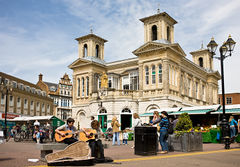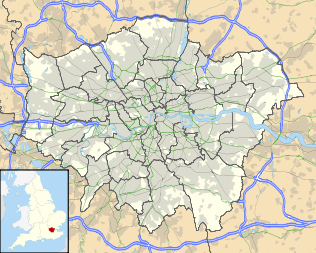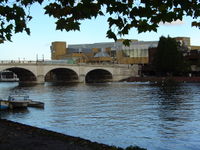Kingston upon Thames
| Kingston upon Thames | |
 Old Town Hall on Market Place |
|
 Kingston upon Thames
|
|
| OS grid reference | |
|---|---|
| - Charing Cross | 10 mi (16 km) NE |
| London borough | Kingston |
| Ceremonial county | Greater London |
| Region | London |
| Country | England |
| Sovereign state | United Kingdom |
| Post town | KINGSTON UPON THAMES |
| Postcode district | KT1, KT2 |
| Dialling code | 020 |
| Police | Metropolitan |
| Fire | London |
| Ambulance | London |
| EU Parliament | London |
| UK Parliament | Kingston and Surbiton |
| Richmond Park | |
| London Assembly | South West |
| List of places: UK • England • London | |
Kingston upon Thames is the principal settlement of the Royal Borough of Kingston upon Thames in South-West London.
It was the ancient market town where Saxon kings were crowned and is now a suburb situated 10 miles (16.1 km) south west of Charing Cross. It is one of the major metropolitan centres identified in the London Plan.[1]
Contents |
History

Kingston was built at the first crossing point of the Thames upstream from London Bridge and a bridge still exists at the same site. Kingston was occupied by the Romans, and later it was either a royal residence or a royal demesne. There is a record of a council held there in 838, at which Egbert of Wessex, King of Wessex, and his son Ethelwulf of Wessex were present; and in this record it is styled Kyningestun famosa illa locus. In Old English, tun, ton or don meant farmstead - so the name Kingston may have been thought to mean farmstead of the kings. Seven Saxon kings are traditionally said to have been crowned at Kingston, while seated on a large stone - The Coronation Stone - that stands outside the Guildhall. There is a local rumour that these Saxon coronations gave Kingston its name, but the records of the 838 council disprove this.[2]
Kingston upon Thames appears in Domesday Book of 1086 as Chingestone and Chingetun(e). It was held by William the Conqueror. Its domesday assets were: a church, five mills, three fisheries worth 10s, 27 ploughs, 40 acres (160,000 m2) of meadow, woodland worth six hogs. It rendered £30.[3]
The first of the charters given to the town of Kingston was granted by King John in 1200 but the oldest one to survive is from 1208 and this document is housed in the town's archives. Other charters were issued by later kings, including Edward IV's charter that gave the town the status of a borough in 1481. Some interesting relics have been discovered to support this history, and statues of some of the Saxon kings and of King John were preserved in a chapel. In 1730 the chapel containing the royal effigies collapsed, burying the sexton, who was digging a grave, the sexton's daughter and another person. The daughter survived this accident and was her father's successor as sexton. Another chapel, The Lovekyn Chapel, still exists. It was founded in 1309 by a former mayor of London, Edward Lovekyn. It is the only private chantry chapel to survive the Reformation.
Kingston sent members to early Parliaments, until a petition by the inhabitants prayed to be relieved from the burden.
Kingston was one of the ancient boroughs to be reformed by the Municipal Corporations Act 1835, becoming the Municipal Borough of Kingston upon Thames. It retained this status until the London Government Act 1963 came into force in 1965, merging Kingston upon Thames with the Municipal Borough of Surbiton and the Municipal Borough of Malden and Coombe to form the London Borough of Kingston upon Thames. At the request of the Council, Queen Elizabeth II granted Kingston another Royal Charter in 1965 entitling it to continue using the title "Royal Borough of Kingston upon Thames" for the enlarged Borough. Before becoming part of Greater London in 1965, Kingston was in the county of Surrey, and some confusion continues because the county hall and offices of Surrey County Council are still in Kingston. For river users, Kingston is still on the "Surrey" bank.
For much of the 20th century, Kingston was a major military aircraft manufacturing centre specialising in fighter aircraft - first with Sopwith Aviation, H G Hawker Engineering, later Hawker Aircraft, Hawker Siddeley and eventually British Aerospace. The legendary Sopwith Camel, Hawker Fury, Hurricane, Hunter and Harrier were all designed and built in the town and examples of all of these aircraft can be seen today at nearby Brooklands Museum in Weybridge. Well known aviation personalities Sydney Camm, Harry Hawker and Tommy Sopwith were responsible for much of Kingston's achievements in aviation. British Aerospace finally closed its Lower Ham Road factory in 1992 part of the site was subsequently redeveloped for housing, the river side part of the site remains as a community centre and sports complex.
The growth and development of Kingston Polytechnic and its transformation into Kingston University has made Kingston a university town.
Kingston today
Central Kingston is a busy predominantly retail centre, with a small number of commercial offices and civic buildings. It has a great many car parks, connected by a one-way system. It is one of the main centres of the south west London bus network, and it is connected to Twickenham, Richmond, Wimbledon, and London Waterloo by National Rail trains.

Shopping is well catered for and is generally towards the upper end of expectations, with a good mixture of familiar High Street chains and more select boutiques. The shopping centre includes a shopping mall, "The Bentall Centre", containing the Bentalls department store and large branches of chain stores found in many British high streets. There is a large branch of the John Lewis department store group, with a Waitrose supermarket, located in the basement. The Rotunda, located in the former Bentalls furniture depository building (a local landmark), includes a bowling alley, fitness centre, a 14-screen Odeon multiplex cinema and some restaurants. Recent developments along the riverside south of Kingston Bridge have added bars, restaurants and a theatre, the Rose Theatre which opened in 2008 with Sir Peter Hall as the director. The ancient market is still held daily in the Market Place.
Kingston's civic buildings include the Guildhall which houses Kingston Council and the magistrates' court, There is also the county court, a local museum and public library. A short distance away is the new crown court building, adjacent to the County Hall Building which houses the main offices of Surrey County Council. Until local government re-organisation in 1965 when Kingston became one of the 33 boroughs of Greater London, it was the County Town of Surrey. Guildford now has this title as Kingston is no longer administered by Surrey. Plans to move these offices to Woking have been scrapped.
Kingston's main open space is the River Thames, with its lively frontage of bars and restaurants. Downstream there is a walk through Canbury Gardens towards Teddington Lock. Upstream there is a promenade crossing the Hogsmill river and reaching almost to Surbiton. Across Kingston Bridge is a tree lined river bank fronting the expanse of Hampton Court Park.
One of the more unusual sights in Kingston is several disused red telephone boxes that have been tipped up to lean against one another in an arrangement resembling dominoes. This sculpture by David Mach was commissioned in 1988 as part of the landscaping for the new Relief Road, and is called Out of Order.

Sport
Kingston is the home of two non-league association football clubs, Kingstonian F.C. and AFC Wimbledon, both of which play at the Kingsmeadow Stadium.
Kingston Athletic Club and Polytechnic Harriers - as of 2009, competing in the National Two division of the British Athetics League - are based at the neighbouring Kingsmeadow athetics stadium.
Kingston Rugby Club is based on the outskirts of the town and Kingston Rowing Club is based on the River Thames. Kingston Regatta takes place on the river at the town in July.
Sport in Kingston is promoted and encouraged by Sport Kingston, an organisation funded by the Royal Borough of Kingston.
Eating and drinking
Kingston has many pubs and restaurants, though several public houses in centre have closed in recent years to become restaurants or bars. The more traditional pubs tend to be in the northern part of the town (Canbury) and include the Park Tavern, Wych Elm and Willoughby Arms. Further south are found the Druid's Head, the Spring Grove, The Cricketers, The Duke Of Buckingham, and several small local pubs around Fairfield. The Druid's Head is notable as one of the first taverns to make the famous dessert syllabub in the 18th century. There are several Chinese, Indian, Thai and Italian restaurants.
Politics and religion
Kingston straddles two Parliamentary constituencies: the area north of the railway line is part of Richmond Park which is represented by Conservative MP Zac Goldsmith; the area south of the railway line (which includes the ancient town centre) is part of Kingston and Surbiton represented by Liberal Democrat Edward Davey. Ecclesiastically, Kingston lies in the Church of England Diocese of Southwark and Roman Catholic Archdiocese of Southwark. The suffragan or Area Bishop of Kingston is the Rt Rev. Dr Richard Ian Cheetham.
Kingston is also the home of the Kingston Synagogue and Kingston Liberal Synagogue.
Kingston also has a Quaker meeting house, a Mosque and a Sikh Gurdwara (On March Lane)
Kingston Green Fair

Kingston Green Fair was held annually from 1987 to 2008 in Canbury Gardens, next to the river, on the Spring Bank Holiday. The word "Green" in the title refers to the ethos of the fair as promoting sustainable development. For instance no meat or other products derived from dead animals were allowed to be sold, and no electricity was permitted on the site unless generated by wind, sun, or bicycle power.[4]
Education
- For education in Kingston upon Thames see the main Royal Borough of Kingston upon Thames, article.
There are several schools in Kingston including:
- Hollyfield School,
- Kingston Grammar School,
- Canbury School,
- Marymount International School (MMI),
- Coombe Girls' School,
- Tolworth Girls' School and Centre for Continuing Education,
- Tiffin School (boys),
- Tiffin Girls' School.
Kingston is also home to Kingston University and Kingston College.
Transport

The town is served by three railway stations on a line into Waterloo Station via New Malden and Wimbledon or via Richmond upon Thames (the long way round). The local stations are Kingston, Norbiton and Hampton Wick. Norbiton is east of the town centre near Kingston Hospital, and Hampton Wick is to the west across the river Thames. Two additional railway stations are located on the main line in nearby Surbiton (which has a more frequent service) and Berrylands. The town originally restricted the coming of the railways as much of its wealth and status were as a direct consequence of the road and stagecoach network developed as a result of its placing as a crossing on the Thames. Local landowners would not consent to the line coming through their land, and in 1838 the rail station was built a few miles out at Surbiton, which was known as 'Kingston Upon Railway". This led to the development of Surbiton. Kingston recognised the need for the railway, and in the 1860s Kingston opened. The line however, due to the landowners resistance, had to take a longer route via Richmond upon Thames. Only later did the line get permission for a faster link, connecting to London Waterloo via Norbiton.
The A3 road runs from central London towards Kingston before by-passing the town to the east. The "Kingston bypass road" was one of the first arterial roads to be built in Britain. It was originally proposed in 1912 to relieve the pressure of traffic in the town centre, but World War I delayed the start of work until 1924. It was opened by Prime Minister Stanley Baldwin on 28 October 1927. Kingston is also served by the A240, the A307 (Portsmouth Road), A308 and A310.
Riverboats run regularly between Kingston and Hampton Court as well as Richmond all during the summer season. There are also direct services to Putney and Westminster from Hampton Court.
Arts
The most notable dramatic arts venue is the Rose Theatre. All Saints Church is host to classical choral and music concerts mostly on Saturdays and houses a Frobenius organ. There are a number of choral societies including the Kingston Orpheus Choir and the Kingston Choral Society, an amateur symphony orchestra the Kingston Philharmonia, and the Kingston and District Chamber Music Society. A number of annual festivals are organised by the Council and Kingston Arts Council including Kingston Readers' Festival, Think-in-Kingston and the Festival of the Voice. Kingston University runs the Stanley Picker Gallery and Kingston Museum has a changing gallery on the first floor.
Media
Kingston has been covered in literature, film and television. It is where the comic Victorian novel Three Men in a Boat by Jerome K. Jerome begins; cannons aimed against the Martians in H. G. Wells' The War of the Worlds are positioned on Kingston Hill; in The Rainbow by D. H. Lawrence the youngest Brangwen dreams of a job in Kingston upon Thames in a long, lyrical passage; Mr. Knightly in Emma by Jane Austen regularly visits Kingston, although the narrative never follows him there. Kingston is referenced (and used as a filming location) in episodes of Monty Python. More recently, a scene from Mujhse Dosti Karoge, a Bollywood film starring Hrithik Roshan as the leading actor, was filmed by the toppled telephone boxes sculpture in Old London Road. A scene in the television programme The Good Life sees Richard Briers get on a 71 bus in 'The Avenue' towards Kingston town centre (albeit this route never served the east side of Surbiton where the series is set). Nipper, the famous "His Master's Voice" (HMV) dog, buried in the town under Lloyds Bank. His owners lived nearby in Fife Road. Also, the 2008 series of 'Primeval', shown on ITV1 in January, featured almost an entire episode filmed inside the Bentall Centre and John Lewis department stores. Kingston featured in Primeval again in May 2009 with several scenes shot in and around the Market Place.
The local newspapers are the weekly paid-for Surrey Comet, which celebrated its 150th year in 2004[5], and the free Kingston Guardian.
Notable people

- See also alumni of local schools, colleges and the university
Notable people born in the town include James Squire, transported convict and brewer in Australia (1754), John Cleland (1709) and John Galsworthy (1867), both authors, Eadweard Muybridge, photographer (1830), Donald Campbell, car and motorboat racer (1921), John Cooper, auto engineer (1923), Derek Bourgeois, composer (1941), Dave Swarbrick, folk fiddle player (1941), Nigel Barley, anthropologist (1947), Steven Wilson, musician (1967), Tom Rowlands of the Chemical Brothers (1971), Jonny Lee Miller (1972), Lisa Faulkner (1973), Kelly Reilly (1977), and Chiké Okonkwo (1982) all actors, Steven Reid, footballer (1981), Matt Cooke, television presenter (1982), Dean Lewington, footballer (1984), Rat Scabies (Christopher Millar) (1957), of The Damned. Jacqueline Wilson grew up,and went to school in Kingston and still lives there today.
International links
Although not officially 'twinned', The Royal Borough of Kingston has a partner city of Oldenburg in Germany and Gwanak-gu, an administrative subdivision of Seoul, in South Korea. Some road signs announce that Kingston is linked with Delft in the Netherlands but this official link has ended.[6]
References
- Sources consulted
- Dickens, Charles, Jr (1994) [1887, 1879]. Dickens's Dictionary of the Thames, 1887 (facsimile ed.). Devon: Old House Books. ISBN 1-873590-12-1. – A guide to the Thames written by the novelist's son.
- Endnotes
- ↑ Mayor of London (February 2008). "London Plan (Consolidated with Alterations since 2004)". Greater London Authority. http://www.london.gov.uk/thelondonplan/docs/londonplan08.pdf.
- ↑ Dickens 1887, op. cit.
- ↑ Surrey Domesday Book
- ↑ Kingston Green Fair.org.uk
- ↑ http://www.surreycomet.co.uk/comet150/intro/
- ↑ Kingston's European and International Partnerships
External links
- Kingston Council official website
- "A Brief History of Kingston upon Thames" by Tim Lambert
- Kingston Museum official website
|
||||||||||||||||||||
|
||||||||
| Section 8: | London Outer Orbital Path | Section 9: |
|---|---|---|
| Ewell | Kingston upon Thames | Hatton Cross |
